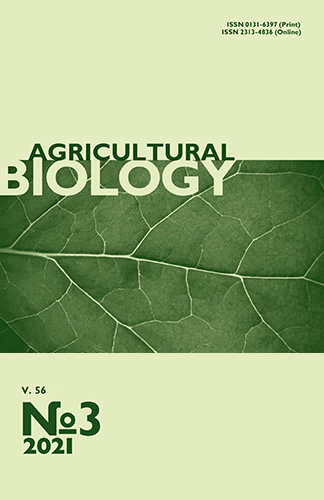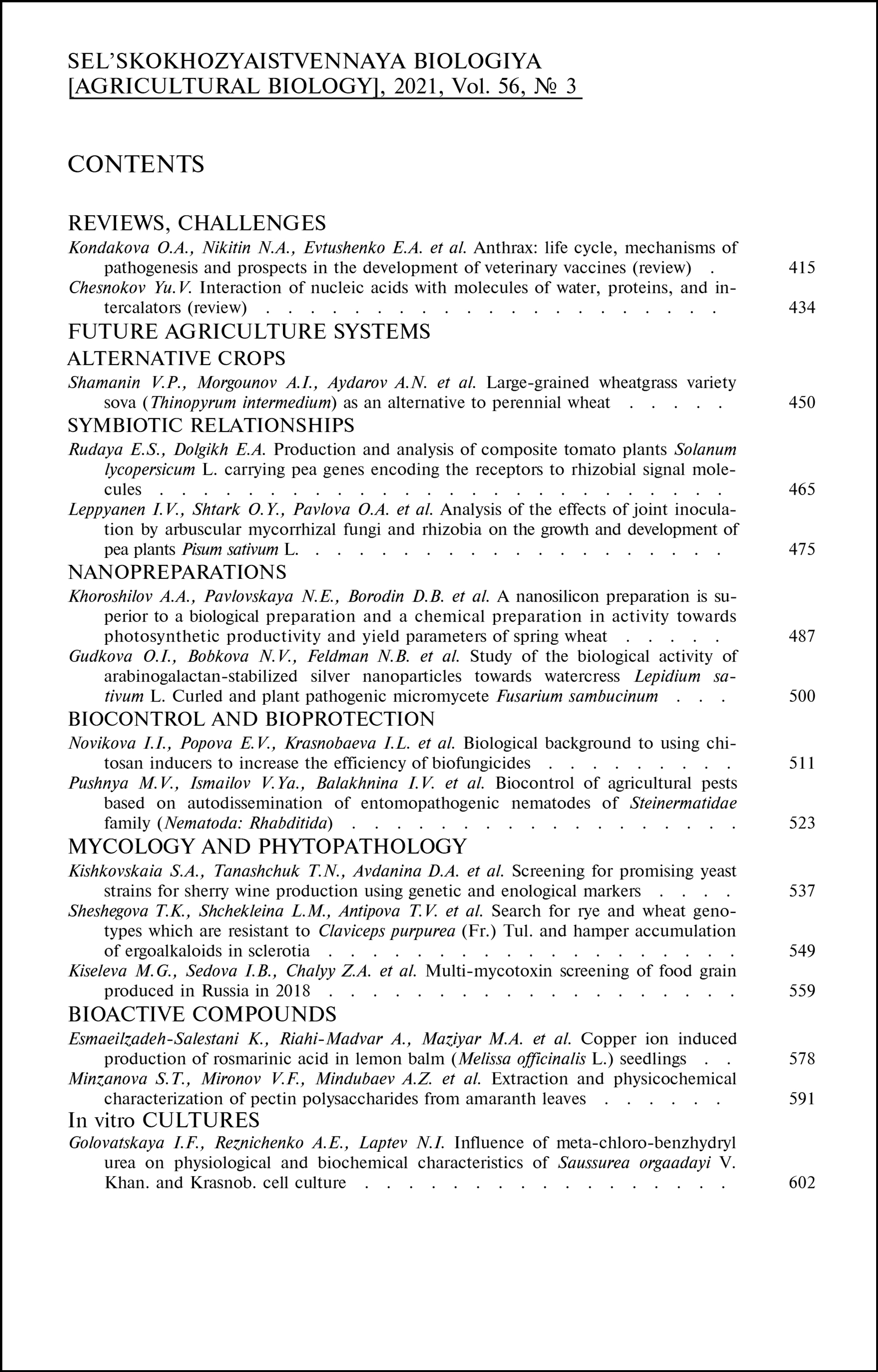doi: 10.15389/agrobiology.2021.3.500eng
UDC: 635.563:581.14:632.9:546.57:539.2
Acknowledgements:
Supported financially by the Russian academic excellence project (Project “5 in 100”)
STUDY OF THE BIOLOGICAL ACTIVITY OF ARABINOGALACTAN-STABILIZED SILVER NANOPARTICLES TOWARDS WATERCRESS Lepidium sativum L. Curled AND PLANT PATHOGENIC MICROMYCETE Fusarium sambucinum
O.I. Gudkova1, N.V. Bobkova1, N.B. Feldman1 ✉, A.N. Luferov1,
T.I. Gromovykh1, I.A. Samylina1, M.A. Ananyan2, S.V. Lutsenko1
1Sechenov First Moscow State Medical University (Sechenov University), the Ministry of Health of the Russian Federation, 8-2, ul. Trubetskaya, Moscow,119991 Russia, e-mail senia501@yandex.ru, bobkovamma@mail.ru, n_feldman@mail.ru (corresponding author ✉), luferovc@mail.ru, gromovykhtatyana@mail.ru, laznata@mail.ru, svlutsenko57@mail.ru;
2Nanoindustry Concern JSC, 4-1, ul. Bardina, Moscow, 119334 Russia, e-mail nanotech@nanotech.ru
ORCID:
Gudkova O.I. orcid.org/0000-0003-3880-5587
Gromovykh T.I. orcid.org/0000-0002-6943-534X
Bobkova N.V. orcid.org/0000-0003-1591-4019
Samylina I.A. orcid.org/0000-0002-4895-0203
Feldman N.B. orcid.org/0000-0001-6098-2788
Ananyan M.A. orcid.org/0000-0002-1588-1475
Luferov A.N. orcid.org/0000-0003-2397-7378
Lutsenko S.V. orcid.org/0000-0002-2017-6025
Received January 15, 2021
Metal nanoparticles (NPs) exhibiting growth-stimulating, antifungal, antibacterial, insecticidal effects and prolonged release of minerals and herbicides, opens up prospects for increasing the yield of crops. Among metal nanoparticles that can find application in agriculture, silver nanoparticles occupy a special place due to a wide spectrum of biological activity. In this work, we have established for the first time that the pre-sowing treatment of seeds of watercress Lepidium sativum L. cv. Curled by silver nanoparticles which are stabilized by the biopolymer arabinogalactan and dioctyl sulfosuccinate affects the germinative energy, laboratory seed germination and some anatomical and morphometric parameters of watercress seedlings. It was shown for the first time that silver nanoparticles have an inhibitory effect on the growth of the phytopathogenic fungus Fusarium sambucinum. This work aimed to assess both the stimulating effect of silver nanoparticles (Ag-NPs) stabilized with arabinogalactan and dioctyl sulfosuccinate on growth of watercress Lepidium sativum L. cv. Curled seedlings and the antifungal effect on a plant pathogenic toxin-producing micromycete Fusarium sambucinum VKPM F-900. The nanoparticles were synthesized by the reduction of silver nitrate in an alkaline medium in the presence of arabinogalactan followed by the addition of dioctyl sulfosuccinate as a stabilizer. The average nanoparticle diameter was 11.40±3.96 nm; zeta potential -24 mV. The effect of silver nanoparticles on germination energy, seed germination, growth of watercress seedling hypocotyl and root was investigated. Seeds were incubated in sols of nanoparticles with various silver concentrations (1.17, 2.34, 4.69, 9.38, 18.75, 37.5, 75, and 150 mg/ml). Control seeds were incubated in water. After incubation, the seeds were germinated in Petri dishes on a wet bed of filter paper in the dark at 20 °С. The seed germination energy was determined on day 3, the laboratory germination — on day 5, the lengths of the hypocotyl and the main root were measured on day 7, and also microscopic analysis of the root sections of seedling treated with sols with stimulating and inhibiting concentrations of Ag (4.69 and 18.75 mg/ml, respectively) was carried out. Antifungal activity of silver sols with concentrations from 9.38 to 300 mg/ml was assessed by the agar diffusion method. Micromycete Fusarium sambucinum Fuckel VKPM F-900 was used as a test culture to determine antifungal activity. Sterile water was used as a control. The incubation of seeds in sols with a silver concentration of 2.34 and 4.69 mg/ml had a stimulating effect on the germination energy and laboratory germination of L. sativum seeds. A dose of silver nanoparticles of 4.69 mg/ml increased the germination energy by 13.5 % and laboratory germination by 11.7 % compared to the control. In addition, the concentrations of silver from 1.17 to 4.69 mg/ml had a significant stimulating effect on root growth (from 34.4 to 79.1 %, respectively) with some deceleration of hypocotyl growth. Seed incubation in sols with a silver concentration of 18.75 mg/ml and higher led to a significant decrease in the germination energy and laboratory germination, as well as suppression of plant growth. Microscopic examination of sections of zone of maturation of the root of seedlings showed that silver sols significantly affect the conductive system of the central axial cylinder. The number of xylem vessels in seedlings treated with silver sol at a stimulating concentration of 4.69 mg/ml was significantly higher compared to the control, which led to a more intensive growth of the root system and the whole plant. Silver nanoparticles also inhibit the growth of F. sambucinum. The growth inhibition zone at a maximum sol concentration of 300 mg/ml was 32.4±4.2 mm in diameter, and at 150 mg/ml it was 28.4±3.9 mm. The minimum concentration inhibiting the visible growth of the test strain F. sambucinum was 18.75 mg/ml (growth inhibition zone 11.7±0.8 mm). The presented data indicate the possibility of using sols of stabilized silver nanoparticles to stimulate seed germination and plant growth and to protect plants against pathogens.
Keywords: silver nanoparticles, plant growth, germinative energy, seed germination, antifungal activity, Lepidium sativum, Fusarium sambucinum.
REFERENCES
- Bhagat Y., Gangadhara K., Rabinal C., Chaudhari G., Ugale P. Nanotechnology in agriculture: a review. Journal of Pure and Applied Microbiology, 2015, 9(1): 737-747.
- Jampílek J., Kráľová K. Application of nanotechnology in agriculture and food industry, its prospects and risks. Ecological Chemistry and Engineering S, 2015, 22(3): 321-361 CrossRef
- Hossain Z., Mustafa G., Komatsu S. Plant responses to nanoparticle stress. International Journal of Molecular Sciences, 2015, 16(11): 26644-26653 CrossRef
- Gusev A.A., Kudrinsky A.A., Zakharova O.V., Klimov A.I., Zherebin P.M., Lisichkin G.V., Vasyukova I.A., Denisov A.N., Krutyakov Y.A. Versatile synthesis of PHMB-stabilized silver nanoparticles and their significant stimulating effect on fodder beet (Beta vulgaris L.). Materials Science and Engineering C, 2016, 62: 152-159 CrossRef
- Zhang B., Zheng L.P., Li W.Y., Wang J.W. Stimulation of artemisinin production in Artemisia annua hairy roots by Ag-SiO2 core-shell nanoparticles. Current Nanoscience, 2013, 9(3): 363-370 CrossRef
- Salama H.M.H. Effects of silver nanoparticles in some crop plants, Common bean (Phaseolus vulgaris L.) and corn (Zea mays L.). International Research Journal of Biotechnology, 2012, 3(10): 190-197.
- Seifsahandi M., Sorooshzadeh A., Rezazadeh H., Naghdiabadi H.A. Effect of nano silver and silver nitrate on seed yield of borage. Journal of Medicinal Plants Research, 2011, 5(2): 171-175.
- Yin L.Y., Cheng Y.W., Espinasse B., Colman B.P., Auffan M., Wiesner M., Rose J., Liu J., Bernhardt E.S. More than the ions: the effects of silver nanoparticles on Lolium multiflorum. Environmental Science and Technology, 2011, 45(6): 2360-2367 CrossRef
- Jiang H.S., Li M., Chang F.Y., Li W., Yin L.Y. Physiological analysis of silver nanoparticles and AgNO3 toxicity to Spirodela polyrhiza. Environmental Toxicology and Chemistry, 2012, 31(8): 1880-1886 CrossRef
- Mirzajani F., Askari H., Hamzelou S., Farzaneh M., Ghassempour A. Effect of silver nanoparticles on Oryza sativa L. and its rhizosphere bacteria. Ecotoxicology and Environmental Safety, 2013, 88: 48-54 CrossRef
- Richard J.L. Some major mycotoxins and their mycotoxicoses — an overview. International Journal of Food Microbiology, 2017, 119(1-2): 3-10 CrossRef
- Khadri H., Alzohairy M., Janardhan A., Kumar A.P., Narasimha G. Green synthesis of silver nanoparticles with high fungicidal activity from olive seed extract. Advances in Nanoparticles, 2013, 2(3): 241-246 CrossRef
- Gajbhiye M., Kesharwani J., Ingle A., Gade A., Rai M. Fungus-mediated synthesis of silver nanoparticles and their activity against pathogenic fungi in combination with fluconazole. Nanomedicine: Nanotechnology, Biology, and Medicine, 2009, 5(4): 382-386 CrossRef
- Elgorban A.M., El-Samawaty A.E.-R.M., Yassin M.A., Sayed S.R., Adil S.F., Elhindi K.M., Bakri M., Khan M. Antifungal silver nanoparticles: Synthesis, characterization and biological evaluation. Biotechnology and Biotechnological Equipment, 2016, 30(1): 56-62 CrossRef
- Mishra S., Singh B.R., Singh A., Keswani C., Naqvi A.H., Singh H.B. Biofabricated silver nanoparticles act as a strong fungicide against Bipolaris sorokiniana causing spot blotch disease in wheat. PLoS ONE, 2014, 9(5): e97881 CrossRef
- Jo Y.-K., Kim B.H., Jung G. Antifungal activity of silver ions and nanoparticles on phytopathogenic fungi. Plant Disease, 2009, 93(10): 1037-1043 CrossRef
- Kim S.W., Jung J.H., Lamsal K., Kim Y.S., Min J.S., Lee Y.S. Antifungal effects of silver nanoparticles (AgNPs) against various plant pathogenic fungi. Mycobiology, 2012, 40(1): 53-58 CrossRef
- Almutairi Z.M., Alharbi A.A. Effect of silver nanoparticles on seed germination of crop plants. Journal of Advances in Agriculture, 2015, 4(1): 280-285 CrossRef
- Nair R., Varghese S.H., Nair B.G., Maekawa T., Yoshida Y., Kumar D.S. Nanoparticulate material delivery to plants. Plant Science, 2010, 179(3): 154-163 CrossRef
- Maity D., Kanti Bain M., Bhowmick B., Sarkar J., Saha S., Acharya K., Chakraborty M., Chattopadhyay D. In situ synthesis, characterization, and antimicrobial activity of silver nanoparticles using water soluble polymer. Journal of Applied Polymer Science, 2011, 122(4): 2189-2196 CrossRef
- Lukman A.I., Gong B., Marjo C.E., Roessner U., Harris A.T. Facile synthesis, stabilization, and anti-bacterial performance of discrete Ag nanoparticles using Medicago sativa seed exudates. Journal of Colloid and Interface Science, 2011, 353(2): 433-444 CrossRef
- Grishchenko L.A., Medvedeva S.A., Aleksandrova G.P., Feoktistova L.P., Sapozhnikov A.N., Sukhov B.G., Trofimov B.A. Redox reactions of arabinogalactan with silver ions and formation of nanocomposites. Russian Journal of General Chemistry, 2006, 76(7): 1111-1116 CrossRef
- Anuradha K., Bangal P., Madhavendra S.S. Macromolecular arabinogalactan polysaccharide mediated synthesis of silver nanoparticles, characterization and evaluation. Macromolecular Research, 2016, 24(2): 152-162 CrossRef
- Alexandrova V.A., Shirokova L.N., Sadykova V.S., Baranchikov A.E. Antimicrobial activity of silver nanoparticles in a carboxymethyl chitin matrix obtained by the microwave hydrothermal method. Applied Biochemistry and Microbiology, 2018, 54(5): 496-500 CrossRef
- Sukhov B.G., Aleksandrova G.P., Grishchenko L.A., Feoktistova L.P., Sapozhnikov A.N., Proidakova O.A., T'Kov A.V., Medvedeva S.A., Trofimov B.A. Nanobiocomposites of noble metals based on arabinogalactan: preparation and properties. Journal of Structural Chemistry, 2007, 48(5): 922-927 CrossRef
- Ahmad A., Mukherjee P., Senapati S., Mandal D., Khan M.I., Kumar R., Sastry M. Extracellular biosynthesis of silver nanoparticles using the fungus Fusarium oxysporum. Colloids and Surfaces B: Biointerfaces, 2003, 28(4): 313-318 CrossRef
- Gurunathan S. Biologically synthesized silver nanoparticles enhance antibiotic activity against Gram-negative bacteria. Journal of Industrial and Engineering Chemistry, 2015, 29: 217-226 CrossRef
- Gurunathan S., Jeong J.K., Han J.W., Zhang X.F., Park J.H., Kim J.H. Multidimensional effects of biologically synthesized silver nanoparticles in Helicobacter pylori, Helicobacter felis, and human lung (L132) and lung carcinoma A549 cells. Nanoscale Research Letters, 2015, 10(1): 1-17 CrossRef
- Lamprecht M.R., Sabatini D.M., Carpenter A.E. CellProfilerTM: free, versatile software for automated biological image analysis. Biotechniques, 2007, 42(1): 71-75 CrossRef
- Balouiri M., Sadiki M., Ibnsouda S.K. Methods for in vitro evaluating antimicrobial activity: a review. Journal of Pharmaceutical Analysis, 2016, 6(2): 71-79 CrossRef
- Shah M., Fawcett D., Sharma S., Tripathy S.K., Poinern G.E.J. Green synthesis of metallic nanoparticles via biological entities. Materials, 2015, 8(11): 7278-7308 CrossRef
- Kaveh R., Li Y.-S., Ranjbar S., Tehrani R., Brueck C.L., Van Aken B. Changes in Arabidopsis thaliana gene expression in response to silver nanoparticles and silver ions. Environmental Science and Technology, 2013, 47(18): 10637-10644 CrossRef
- Geisler-Lee J., Wang Q., Yao Y., Zhang W., Geisler M., Li K., Huang Y., Chen Y., Kolmakov A., Ma X. Phytotoxicity, accumulation and transport of silver nanoparticles by Arabidopsis thaliana. Nanotoxicology, 2013, 7(3): 323-337 CrossRef
- Velmurugan N., Kumar G., Han S.S., Nahm K.S., Lee Y.S. Synthesis and characterization of potential fungicidal silver nano-sized particles and chitosan membrane containing silver particles. Iranian Polymer Journal (English Edition), 2009, 18(5): 383-392.












